Identification of Crucial Amino Acid Residues Involved in Agonist Signaling at the GPR55 Receptor
- PMID: 28005346
- PMCID: PMC5338039
- DOI: 10.1021/acs.biochem.6b01013
Identification of Crucial Amino Acid Residues Involved in Agonist Signaling at the GPR55 Receptor
Abstract
GPR55 is a newly deorphanized class A G-protein-coupled receptor that has been implicated in inflammatory pain, neuropathic pain, metabolic disorder, bone development, and cancer. Few potent GPR55 ligands have been identified to date. This is largely due to an absence of information about salient features of GPR55, such as residues important for signaling and residues implicated in the GPR55 signaling cascade. The goal of this work was to identify residues that are key for the signaling of the GPR55 endogenous ligand, l-α-lysophosphatidylinositol (LPI), as well as the signaling of the GPR55 agonist, ML184 {CID 2440433, 3-[4-(2,3-dimethylphenyl)piperazine-1-carbonyl]-N,N-dimethyl-4-pyrrolidin-1-ylbenzenesulfonamide}. Serum response element (SRE) and serum response factor (SRF) luciferase assays were used as readouts for studying LPI and ML184 signaling at the GPR55 mutants. A GPR55 R* model based on the recent δ-opioid receptor (DOR) crystal structure was used to interpret the resultant mutation data. Two residues were found to be crucial for agonist signaling at GPR55, K2.60 and E3.29, suggesting that these residues form the primary interaction site for ML184 and LPI at GPR55. Y3.32F, H(170)F, and F6.55A/L mutation results suggested that these residues are part of the orthosteric binding site for ML184, while Y3.32F and H(170)F mutation results suggest that these two residues are part of the LPI binding pocket. Y3.32L, M3.36A, and F6.48A mutation results suggest the importance of a Y3.32/M3.36/F6.48 cluster in the GPR55 signaling cascade. C(10)A and C(260)A mutations suggest that these residues form a second disulfide bridge in the extracellular domain of GPR55, occluding ligand extracellular entry in the TMH1-TMH7 region of GPR55. Taken together, these results provide the first set of discrete information about GPR55 residues important for LPI and ML184 signaling and for GPR55 activation. This information should aid in the rational design of next-generation GPR55 ligands and the creation of the first high-affinity GPR55 radioligand, a tool that is sorely needed in the field.
Figures
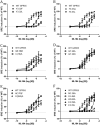
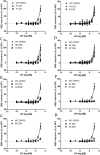

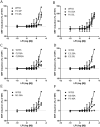

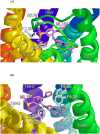
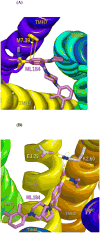




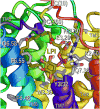
Similar articles
-
Structural basis for lipid-mediated activation of G protein-coupled receptor GPR55.Nat Commun. 2025 Feb 25;16(1):1973. doi: 10.1038/s41467-025-57204-y. Nat Commun. 2025. PMID: 40000629 Free PMC article.
-
A selective antagonist reveals a potential role of G protein-coupled receptor 55 in platelet and endothelial cell function.J Pharmacol Exp Ther. 2013 Jul;346(1):54-66. doi: 10.1124/jpet.113.204180. Epub 2013 May 2. J Pharmacol Exp Ther. 2013. PMID: 23639801
-
Identification of the GPR55 agonist binding site using a novel set of high-potency GPR55 selective ligands.Biochemistry. 2011 Jun 28;50(25):5633-47. doi: 10.1021/bi200010k. Epub 2011 Jun 1. Biochemistry. 2011. PMID: 21534610 Free PMC article.
-
The actions and metabolism of lysophosphatidylinositol, an endogenous agonist for GPR55.Prostaglandins Other Lipid Mediat. 2013 Dec;107:103-16. doi: 10.1016/j.prostaglandins.2013.05.004. Epub 2013 May 25. Prostaglandins Other Lipid Mediat. 2013. PMID: 23714700 Review.
-
GPR55, a lysophosphatidylinositol receptor with cannabinoid sensitivity?Curr Top Med Chem. 2010;10(8):799-813. doi: 10.2174/156802610791164229. Curr Top Med Chem. 2010. PMID: 20370712 Review.
Cited by
-
Methods for the Development of In Silico GPCR Models.Methods Enzymol. 2017;593:405-448. doi: 10.1016/bs.mie.2017.05.005. Epub 2017 Jul 14. Methods Enzymol. 2017. PMID: 28750813 Free PMC article.
-
Evaluating the Antitumor Potential of Cannabichromene, Cannabigerol, and Related Compounds from Cannabis sativa and Piper nigrum Against Malignant Glioma: An In Silico to In Vitro Approach.Int J Mol Sci. 2025 Jun 13;26(12):5688. doi: 10.3390/ijms26125688. Int J Mol Sci. 2025. PMID: 40565152 Free PMC article.
-
Peptide targeting of lysophosphatidylinositol-sensing GPR55 for osteoclastogenesis tuning.Cell Commun Signal. 2021 Apr 26;19(1):48. doi: 10.1186/s12964-021-00727-w. Cell Commun Signal. 2021. PMID: 33902596 Free PMC article.
-
Novel Potent and Selective Agonists of the GPR55 Receptor Based on the 3-Benzylquinolin-2(1H)-One Scaffold.Pharmaceuticals (Basel). 2022 Jun 21;15(7):768. doi: 10.3390/ph15070768. Pharmaceuticals (Basel). 2022. PMID: 35890067 Free PMC article.
-
Effect of Fatty Acyl Composition for Lysophosphatidylinositol on Neuroinflammatory Responses in Primary Neuronal Cultures.J Mol Neurosci. 2025 Mar 14;75(1):35. doi: 10.1007/s12031-025-02326-7. J Mol Neurosci. 2025. PMID: 40085305
References
-
- Henstridge CM, Balenga NA, Ford LA, Ross RA, Waldhoer M, Irving AJ. The GPR55 ligand L-alpha-lysophosphatidylinositol promotes RhoA-dependent Ca2+ signaling and NFAT activation. Faseb J. 2009;23(1):183–93. - PubMed
- Oka S, Toshida T, Maruyama K, Nakajima K, Yamashita A, Sugiura T. 2-Arachidonoyl-sn-glycero-3-phosphoinositol: A Possible Natural Ligand for GPR55. Journal of biochemistry. 2009;145(1):13–20. - PubMed
- Oka S, Nakajima K, Yamashita A, Kishimoto S, Sugiura T. Identification of GPR55 as a lysophosphatidylinositol receptor. Biochem Biophys Res Commun. 2007;362(4):928–34. - PubMed
-
- Sawzdargo M, Nguyen T, Lee DK, Lynch KR, Cheng R, Heng HH, George SR, O'Dowd BF. Identification and cloning of three novel human G protein-coupled receptor genes GPR52, PsiGPR53 and GPR55: GPR55 is extensively expressed in human brain. Brain Res Mol Brain Res. 1999;64(2):193–8. - PubMed
- Staton PC, Hatcher JP, Walker DJ, Morrison AD, Shapland EM, Hughes JP, Chong E, Mander PK, Green PJ, Billinton A, Fulleylove M, Lancaster HC, Smith JC, Bailey LT, Wise A, Brown AJ, Richardson JC, Chessell IP. The putative cannabinoid receptor GPR55 plays a role in mechanical hyperalgesia associated with inflammatory and neuropathic pain. Pain. 2008;139(1):225–36. - PubMed
- Whyte LS, Ryberg E, Sims NA, Ridge SA, Mackie K, Greasley PJ, Ross RA, Rogers MJ. The putative cannabinoid receptor GPR55 affects osteoclast function in vitro and bone mass in vivo. Proceedings of the National Academy of Sciences of the United States of America. 2009;106(38):16511–6. - PMC - PubMed
- Ford LA, Roelofs AJ, Anavi-Goffer S, Mowat L, Simpson DG, Irving AJ, Rogers MJ, Rajnicek AM, Ross RA. A role for L-alpha-lysophosphatidylinositol and GPR55 in the modulation of migration, orientation and polarization of human breast cancer cells. Br J Pharmacol. 2010;160(3):762–71. - PMC - PubMed
- Andradas C, Caffarel MM, Perez-Gomez E, Salazar M, Lorente M, Velasco G, Guzman M, Sanchez C. The orphan G protein-coupled receptor GPR55 promotes cancer cell proliferation via ERK. Oncogene. 2010;30:245–252. - PubMed
- Pineiro R, Maffucci T, Falasca M. The putative cannabinoid receptor GPR55 defines a novel autocrine loop in cancer cell proliferation. Oncogene. 2010;30:142–152. - PubMed
-
- Heynen-Genel S, Dahl R, Shi S, Milan L, Hariharan S, Sergienko E, Hedrick M, Dad S, Stonich D, Su Y, Vicchiarelli M, Mangravita-Novo A, Smith LH, Chung TDY, Sharir H, Caron MG, Barak LS, Abood ME. Screening for Selective Ligands for GPR55 - Antagonists. Probe Reports NIH Molecular Libraries Program. 2010 - PubMed
- Heynen-Genel S, Dahl R, Shi S, Milan L, Hariharan S, Bravo Y, Sergienko E, Hedrick M, Dad S, Stonich D, Su Y, Vicchiarelli M, Mangravita-Novo A, Smith LH, Chung TDY, Sharir H, Barak LS, Abood ME. Screening for Selective Ligands for GPR55 - Agonists. Probe Reports NIH Molecular Libraries Program. 2010 - PubMed
-
- Heynen-Genel S, Dahl R, Shi S, Milan L, Hariharan S, Bravo Y, Sergienko E, Hedrick M, Dad S, Stonich D, Su Y, Vicchiarelli M, Mangravita-Novo A, Smith LH, Chung TDY, Sharir H, Barak LS, Abood ME. Screening for Selective Ligands for GPR55. Probe Reports NIH Molecular Libraries Program. 2010
MeSH terms
Substances
Grants and funding
LinkOut - more resources
Full Text Sources
Other Literature Sources
Research Materials
Miscellaneous

